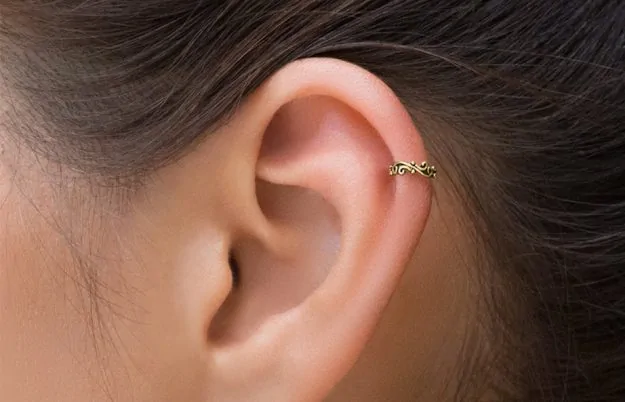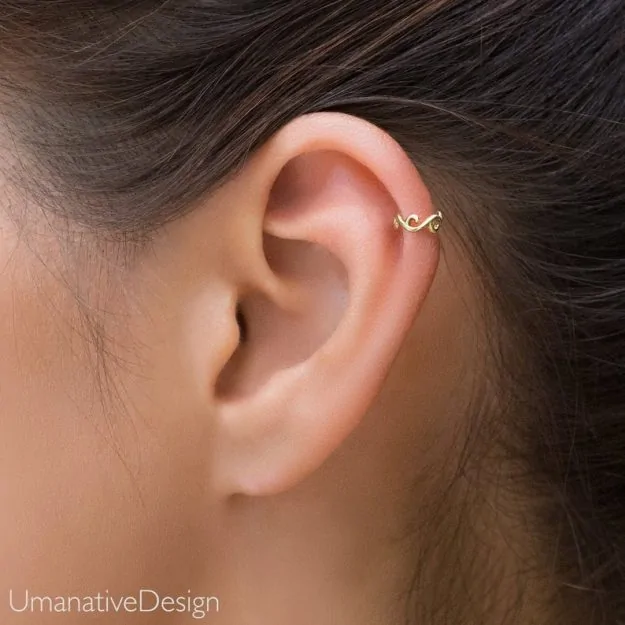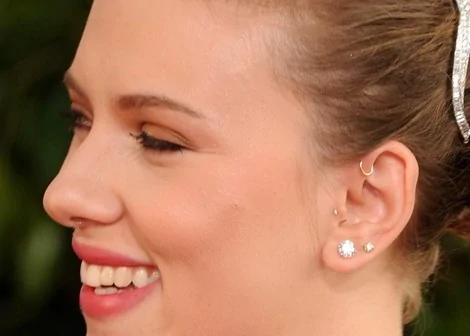
| Location: | Upper rim of the ear |
| Healing: | 3-6 Months |
| Age Limit: | 16 with ID / 13 with Parents |
| Price: | Around $20 - $50 |
| Pain Rating: | Medium |
A pinna piercing is placed at the top of the outer ear rim. A forward pinna piercing is located on the arch where your ear connects to your head. Pinna piercings are very similar to auricle piercings but located higher up the ear. Find more pinna piercing advice and jewellery tips by reading below.
Pinna piercing aka Helix Piercing

Let's take a closer look
Piercings: the belly-button, the traditional lobe, the medusa piercing, the nipple, the prince Albert. Only hark! - on the scene comes the latest and trendiest piercing of them all: the pinna piercing. The pinna, in addition to causing alliteration when used in conjunction with the word 'piercing', is located on the outer rim of the ear, near the top. It is very similar to what is known as an 'auricle' piercing, only the pinna is higher up on the ear.
The pinna piercing can also be called a helix piercing, only the latter is much less fun to say due to the total lack of alliteration. The pinna piercing is a cartilage piercing, however they ordinarily heal very quickly. Part of the reason for the popularity of the pinna piercing is how versatile it is: rings, hoops, bars, cuffs, or anything else you feel like sticking in the top of your ear.
The standard healing time for a pinna piercing is 3-9 months. The success of your piercing depends on on number of different factors, like the material used in your ring, and how well you take care of it. A ring made from a bio-compatible plastic will definitely help you piercing to turn out well, as will regular cleaning, and an increase in your mineral intake. It is recommended, however, when cleaning your healing piercing not to use a particularly harsh soap, as this can cause irritation or in extreme cases even an infection. One alternative recommendation is to simply soak your ear in salty water (use 1 teaspoon of sea salt per 8 oz. of warm water) for 5-10 minutes every day.
The above advice concerning the care of your piercing is especially important in the case of a pinna piercing, since studies have shown that infections in this particular area of the ear can lead to something called 'auricular perichondritis'. This is a type of soft tissue infection, which can lead to a loss of cartilage and to a deformity of the ear (sometimes called 'cauliflower ear'). Studies have warned that the people who ordinarily give these piercings, such as jewellers, tattooists, or hair dressers, are generally not aware of this risk of infection and resulting deformity associated with pinna piercings, and that even prompt action taken after the first signs of infection are shown, is often not enough to prevent this deformity from occurring.
This may take the wind out of your sails, if your heart is set on getting a pinna piercing; but it is better that you know the risks. You'll just have to decide if looking super cool is worth having a funny-looking ear for the rest of your life. However, if you do decide to go through with it anyway, do not hesitate to see a doctor immediately if anything looks wrong with your new piercing.
Another fun fact: the pinna piercing, when used to indicate a piercing very high on the rim of your ear, is actually an incorrect use of the term 'pinna'.
The ear is made up of three parts:
- The pinna or auricle, the outer ear, which captures sound
- The auditory canal through which the sound from the pinna travels into the inner ear,
- The ear drum that converts the sound to nerve impulses.
Since there is no way anyone is ever going to pierce the 2nd or 3rd part of the ear, this means that every single ear piercing is a pinna piercing!
So, if you're caught up with the idea of all the fashionable objects you can stick in the top of your ear, you may want to consider:
1.) that you are using the term 'pinna' incorrectly
2.) that there is a real possibility of permanently deforming your ear, and
3.) that, since your pinna (in the wider sense of your entire outer ear used above) is not meant for decoration, but to capture sound, this means that seriously changing the shape of your ear can affect your sense of hearing (probably not for the better). That doesn't mean you definitely shouldn't do it, just that you should be aware of the risks (as well as the poor use of language) associated with the pinna piercing.

